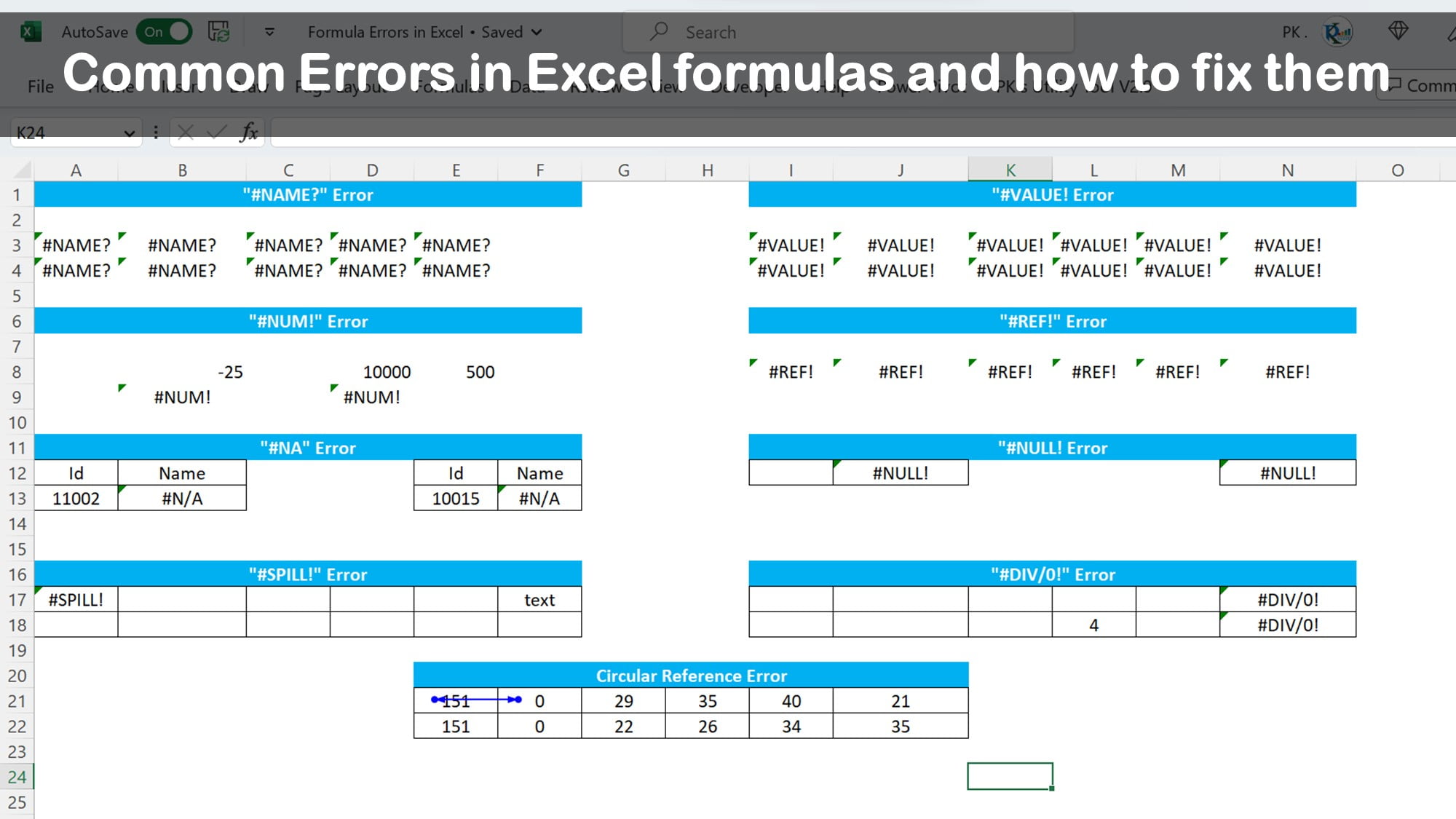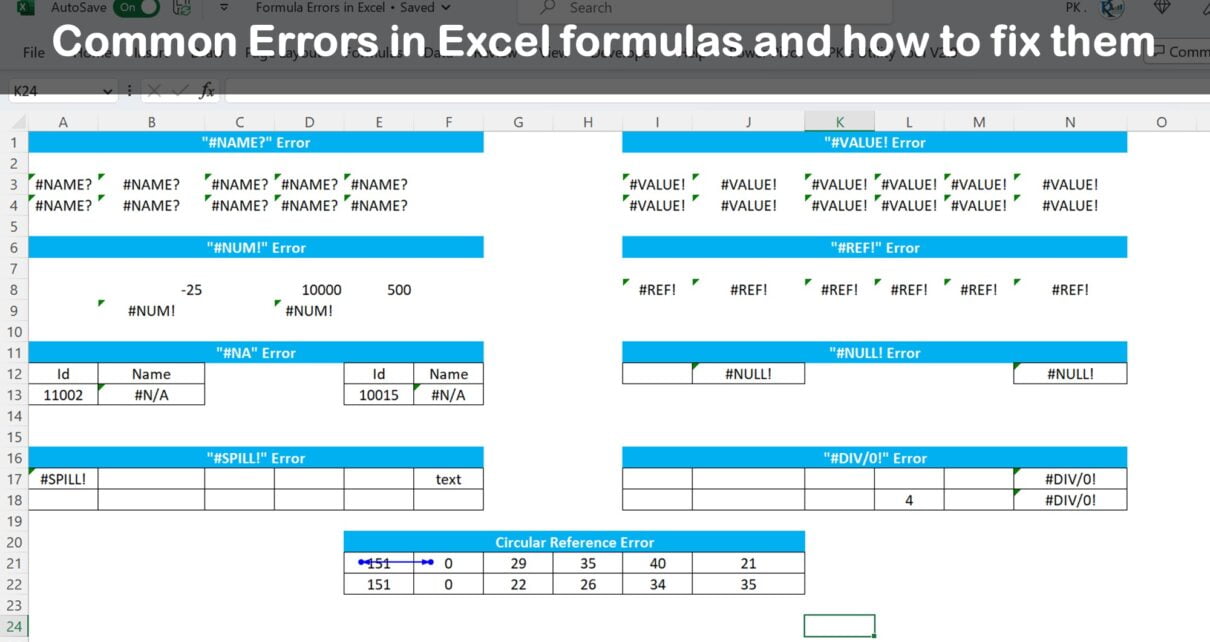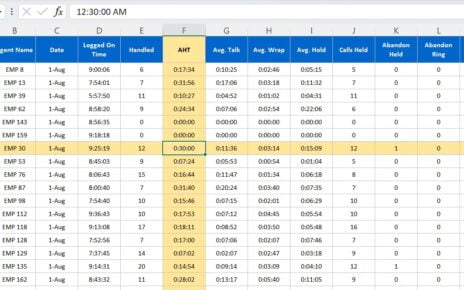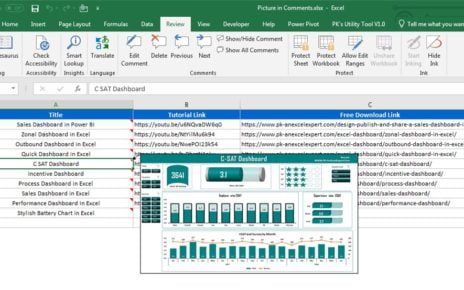Excel is a magnificent tool for managing and analyzing vast amounts of data, with formulas being a critical aspect of this. However, when these formulas go awry, they can cause frustration and a massive time sink. In this blog post, we will explore the Common Errors in Excel formulas and demonstrate how to fix them with ease.
Getting Started
Formulas in Excel are mathematical expressions that perform computations using the data in your spreadsheet. They are an indispensable tool for streamlining routine tasks, digging deeper into data, and uncovering valuable insights. Despite their usefulness, it is common for formula errors to arise and compromise the accuracy and dependability of your data.
Common Errors in Excel formulas and Solutions
Below are the Common Errors in Excel formulas-

#NAME? Error:
The confounding #NAME? error in Excel strikes when a formula incorporates a text string that fails to be acknowledged as a legitimate function name, defined name, or named range. This issue can arise from misspelling a function or from a missing defined name or named range. To combat this perplexing problem, it’s imperative to double check that the function name is spelled correctly and that the named range or defined name is established. If the text string is meant to symbolize a value or text string, enclosing it within double quotation marks can be the solution. Additionally, verifying the proper spreadsheet language selection in formula options is crucial in resolving the #NAME? error, allowing the formula to return the intended result.
Solution:
To resolve the #NAME? error, inspect the formula for any spelling errors and make sure the range of cells is properly defined. Additionally, confirm that the add-ins utilized are both installed and enabled.
#VALUE! Error:
The #VALUE! blunder in Excel arises when a formula endeavors to execute an arithmetic operation on something that is not a numerical value. This mishap could occur if the formula incorporates a text string instead of a numerical quantity, or if a cell reference yields an error result, instead of a number. To dispel the #VALUE! error, it is crucial to affirm that every single value utilized in the formula are numerical. If a text string is meant to be part of the calculation, it must be enveloped by double quotation marks. It is also of utmost importance to verify that cell references in the formula produce numerical values and not errors or text. By rectifying these discrepancies, the #VALUE! error can be remedied, allowing the formula to perform its calculations accurately.
Solution:
To combat the #VALUE! error, cross-check the data type of the cells utilized in the formula and hunt for mismatched parentheses. For instance, attempting to add a text value to a numeric value will result in the #VALUE! error. To remedy the situation, convert the text value to a numeric value or wrap the text value in the TEXT function.
#NUM! Error:
This error occurs when a formula contains an invalid argument or a number that is too large or too small.
Solution:
To resolve this, Check the formula and make sure that the arguments are valid and within the acceptable range.
#REF! error:
The #REF! error in Excel occurs when a formula contains an invalid cell reference. This could happen when a cell or range that the formula refers, you have deleted that cell or range, or when a formula contains a typo in a cell reference. To resolve the #REF! error, check the cell references used in the formula and make sure they are valid. If a cell or range has been deleted, replace the reference with a valid one. If a typo exists in a cell reference, correct the reference so it is accurate. By fixing these issues, the #REF! error can be resolved, and the formula will reference the correct cells, producing accurate results.
Solution:
To resolve this, update the formula to reference the correct cell.
#N/A Error:
The #N/A error in Excel indicates that the formula is unable to find the data it needs. This could occur from several causes: the formula is utilizing a function that simply can’t find the relevant data, or it’s utilizing an incorrect cell reference. To resolve this error, it’s crucial to take a closer look at the data the formula is attempting to use. Make certain that it exists, and that it’s been entered into in a correct manner. Additionally, if a function is involved, double-check that the right arguments are being placed, and that they’ve been entered correctly.
Solution:
To tackle the #N/A error, leverage the IFNA function. The IFNA function grants you the power to specify a value if a formula returns the #N/A error, and a different value if the formula proves successful. For instance, =IFNA(VLOOKUP(A1,B1:C10,2,FALSE), “Not found”) will return “Not found” if the VLOOKUP formula in A1 returns the #N/A error. To guarantee the formula is utilizing the correct data, verify the range of cells.
#NULL! error:
The #NULL! error in Excel occurs when a formula references a cell range that is missing a value or a cell reference which is not valid. This error can appear when referencing a range that includes a blank cell. An incorrect syntax or misspelled reference can also cause the error. To resolve it, verify the cell reference in the formula and make sure it is correct. If a cell range is missing a value, add the missing value. You can use the IFERROR function to capture the error and return a default value instead of the error message. Make sure to use consistent and accurate cell references in formulas to prevent errors.
Solution:
To resolve this, replace the space with a comma.
#SPILL! Error:
This error occurs when a formula returns an array and fit that we don’t have the blank space.
Solution:
To resolve this, delete the data available within the spill range.
#DIV/0! Error:
The #DIV/0! error occurs when a formula tries to divide by zero. This can cause problems when calculating ratios or percentages.
Solution:
To beat the #DIV/0! error, utilize the IFERROR function. The IFERROR function allows you to specify a value in case a formula returns an error, and a different value if the formula proves successful. For example, =IFERROR(A1/B1, 0) will return 0 if the formula in A1/B1 returns the #DIV/0! error. To visually identify #DIV/0! errors, add conditional formatting.
Circular Reference Error
A circular reference, an enigma in the world of Excel, is a formula that refers to its own value, creating a perplexing and never-ending loop. This error can lead to Excel’s shutdown or a drastic reduction in its performance and can seriously compromise the veracity of your data.
Solution:
To beat the circular reference error, make use of the Iterative Calculation feature. To break the circular reference, add intermediate cells that provide intermediate results for the formula.
Conclusion
This blog post explored the most Common Errors in Excel formulas and the corresponding solutions. Acquiring a deeper understanding of these errors and their solutions is crucial to ensuring the reliability and accuracy of your data. Regardless of whether you are an Excel newbie or a seasoned expert, continuously monitoring your formulas for errors and promptly fixing them is vital.
Visit our YouTube channel to learn step-by-step video tutorials
Watch the step-by-step video tutorial for Common Errors in Excel formulas and Solutions:



